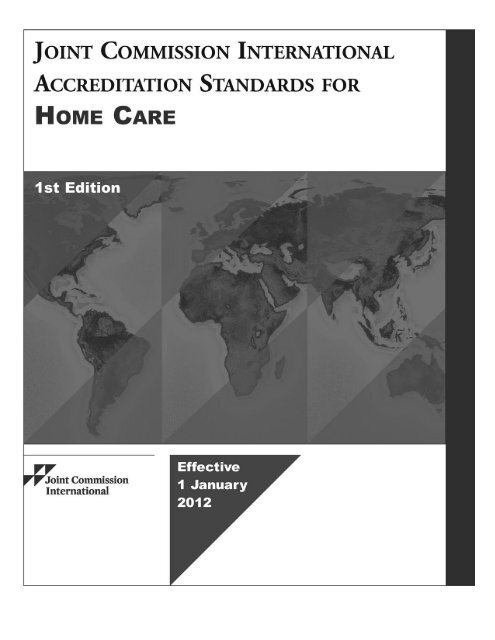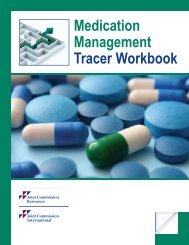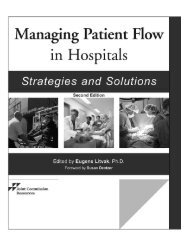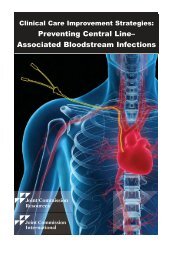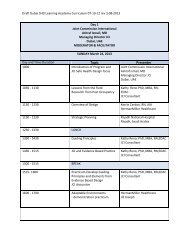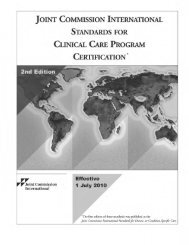Download 'Sample Pages' - Store - Joint Commission International
Download 'Sample Pages' - Store - Joint Commission International
Download 'Sample Pages' - Store - Joint Commission International
Create successful ePaper yourself
Turn your PDF publications into a flip-book with our unique Google optimized e-Paper software.
<strong>Joint</strong> <strong>Commission</strong> <strong>International</strong> Accreditation Standards for Home Care, 1st Edition<br />
<strong>Joint</strong> <strong>Commission</strong> <strong>International</strong><br />
A division of <strong>Joint</strong> <strong>Commission</strong> Resources, Inc.<br />
The mission of <strong>Joint</strong> <strong>Commission</strong> <strong>International</strong> (JCI) is to improve the safety and quality of care in the international<br />
community through the provision of education, publications, consultation, and evaluation services.<br />
<strong>Joint</strong> <strong>Commission</strong> Resources educational programs and publications support, but are separate from, the<br />
accreditation activities of <strong>Joint</strong> <strong>Commission</strong> <strong>International</strong>. Attendees at <strong>Joint</strong> <strong>Commission</strong> Resources educational<br />
programs and purchasers of <strong>Joint</strong> <strong>Commission</strong> Resources publications receive no special consideration<br />
or treatment in, or confidential information about, the accreditation process.<br />
© 2012 <strong>Joint</strong> <strong>Commission</strong> <strong>International</strong><br />
All rights reserved. No part of this publication may be reproduced in any form or by any means without<br />
written permission from the publisher.<br />
Printed in the U.S.A. 5 4 3 2 1<br />
Requests for permission to make copies of any part of this work should be mailed to<br />
Permissions Editor<br />
Department of Publications<br />
<strong>Joint</strong> <strong>Commission</strong> Resources<br />
One Renaissance Boulevard<br />
Oakbrook Terrace, Illinois 60181 U.S.A.<br />
permissions@jcrinc.com<br />
ISBN: 978-1-59940-728-9<br />
Library of Congress Control Number: 2011945756<br />
For more information about <strong>Joint</strong> <strong>Commission</strong> Resources, please visit http://www.jcrinc.com.<br />
For more information about <strong>Joint</strong> <strong>Commission</strong> <strong>International</strong>, please visit<br />
http://www.jointcommissioninternational.org.<br />
ii
Contents<br />
Foreword..........................................................................................................................v<br />
<strong>Joint</strong> <strong>Commission</strong> <strong>International</strong> Standards Subcommittee and Expert Panel........................vii<br />
Introduction......................................................................................................................1<br />
<strong>Joint</strong> <strong>Commission</strong> <strong>International</strong> Policies and Procedures.......................................................7<br />
Section I: Patient-Centered Standards..................................................................... 37<br />
<strong>International</strong> Patient Safety Goals (IPSG).................................................... 39<br />
Patient Access and Assessment (PAA)............................................................ 45<br />
Patient Rights and Responsibilities (PRR).................................................... 59<br />
Patient Care and Continuity of Care (PCC).................................................. 73<br />
Patient Medication Management (PMM)..................................................... 85<br />
Patient and Family Education (PFE)............................................................. 95<br />
Section II: Health Care Organization Management Standards.............................. 103<br />
Improvement in Quality and Patient Safety (IQS)...................................... 105<br />
Infection Prevention and Control (IPC)..................................................... 121<br />
Management and Safety of the Environment (MSE)................................... 127<br />
Staff Qualifications and Education (SQE)................................................... 139<br />
Governance and Leadership (GAL)............................................................. 157<br />
Communication and Information Management (CIM).............................. 173<br />
Glossary........................................................................................................................187<br />
Index............................................................................................................................197<br />
iii
Foreword<br />
<strong>Joint</strong> <strong>Commission</strong> <strong>International</strong> (JCI) is very pleased to present this first edition of the international standards<br />
for home care organizations. Formerly the accreditation of home care organizations was under the international<br />
care continuum standards. As the home care field grows with the aging of populations in many countries it was<br />
time to draw these standards out into a separate manual.<br />
JCI standards are truly international in their development and revision. The process of developing standards is<br />
actively overseen by an expert international task force, whose members are drawn from each of the world’s populated<br />
continents. In addition, the standards were evaluated by individuals around the world via an Internetbased<br />
field review, as well as considered by JCI Regional Advisory Councils in Asia Pacific, Europe, and the<br />
Middle East and other experts from the home care field. This set of home care standards joins the suite of JCI<br />
standards related to Ambulatory Care, Clinical Laboratories, Long Term Care, Hospitals, Medical Transport,<br />
Primary Care, and Clinical Care Program Certification. JCI standards are the basis for accreditation and<br />
certification of individual health care facilities and programs around the world. In addition, JCI standards have<br />
been used to develop and to establish accreditation programs in many countries and have been used by public<br />
agencies, health ministries, and others seeking to evaluate and to improve the safety and quality of patient care.<br />
This first edition reflects the dynamic changes occurring around the globe in the home care environment. This<br />
edition also introduces the <strong>International</strong> Patient Safety Goals, practical actions home care organizations can<br />
take to measurably improve patient safety. In addition, many other changes have their origin in the knowledge<br />
gained from the analysis of patient safety incidents and their root causes. Many of these changes are identified<br />
in the Introduction that follows.<br />
As with all JCI standards, this edition contains the complete set of standards, statements of intent for each<br />
standard, and measurable elements for assessing compliance with each standard. This structure will permit<br />
readers to identify and to understand the specific requirements embodied in the standards.<br />
JCI was created in 1998 as the international arm of The <strong>Joint</strong> <strong>Commission</strong> (United States), and more than<br />
12 years later, this new edition of the standards once again reaffirms JCI’s mission to improve the safety and<br />
quality of patient care around the world.<br />
For further information on the home care and other accreditation and certification programs of JCI, the <strong>International</strong><br />
Patient Safety Goals, and other JCI initiatives, assistance in developing a country-specific accreditation<br />
program, or support in preparing for accreditation, please contact us at<br />
<strong>Joint</strong> <strong>Commission</strong> <strong>International</strong> Accreditation<br />
1515 West 22nd Street, Suite 1300W<br />
Oak Brook, IL 60523 U.S.A.<br />
+1-630-268-7400<br />
JCIAccreditation@jcrinc.com<br />
JCI well understands that standards are continually a “work in progress.” In that spirit, we welcome comments<br />
and suggestions for improvement.<br />
Paula Wilson<br />
President and CEO<br />
<strong>Joint</strong> <strong>Commission</strong> <strong>International</strong>
Introduction<br />
This first edition of the <strong>Joint</strong> <strong>Commission</strong> <strong>International</strong> Accreditation Standards for Home Care contains all the<br />
standards, intent statements, measurable elements of standards, accreditation policies and procedures, and a<br />
glossary of key terms. This Introduction is designed to provide you with information on the following topics:<br />
• The benefits of accreditation<br />
• <strong>Joint</strong> <strong>Commission</strong> <strong>International</strong> (JCI) and its relationship to The <strong>Joint</strong> <strong>Commission</strong> (US)<br />
• The international accreditation initiatives of JCI<br />
• The origin of the standards and how they are organized<br />
• How to use this standards manual<br />
• Why the care continuum standards have been changed to separate standards for long term care and<br />
home care<br />
If, after reading this publication, you have questions about the standards or the accreditation process, please<br />
contact JCI. Contact information is located in the Foreword (preceding this section).<br />
What is accreditation?<br />
Accreditation is a process in which an entity, separate and distinct from the health care organization, usually<br />
nongovernmental, assesses the health care organization to determine if it meets a set of requirements (standards)<br />
designed to improve the safety and quality of care. Accreditation is usually voluntary. Accreditation<br />
standards are usually regarded as optimal and achievable. Accreditation provides a visible commitment by an<br />
organization to improve the safety and quality of patient care, to ensure a safe care environment, and to continually<br />
work to reduce risks to patients and staff. Accreditation has gained worldwide attention as an effective<br />
quality evaluation and management tool.<br />
What are the benefits of accreditation?<br />
The accreditation process is designed to create a culture of safety and quality within an organization that strives<br />
to continually improve patient care processes and results. In doing so, organizations<br />
• improve public trust that the organization is concerned for patient safety and the quality of care;<br />
• provide a safe and efficient work environment that contributes to worker satisfaction;<br />
• negotiate with sources of payment for care with data on the quality of care;<br />
• listen to patients and their families, respect their rights, and involve them in the care process as partners;<br />
• create a culture that is open to learning from the timely reporting of adverse events and safety concerns;<br />
and<br />
• establish collaborative leadership that sets priorities for and continuous leadership for quality and patient<br />
safety at all levels.<br />
What is JCI’s relationship to The <strong>Joint</strong> <strong>Commission</strong>?<br />
JCI is the international arm of The <strong>Joint</strong> <strong>Commission</strong> (US); JCI’s mission is to improve the quality and safety<br />
of health care in the international community.
<strong>Joint</strong> <strong>Commission</strong> <strong>International</strong> Accreditation Standards for Home Care, 1st Edition<br />
For more than 75 years, The <strong>Joint</strong> <strong>Commission</strong> (US) and its predecessor organization have been dedicated to<br />
improving the quality and safety of health care services. Today, The <strong>Joint</strong> <strong>Commission</strong> is the largest accreditor<br />
of health care organizations in the United States—it surveys more than 19,000 health care programs through<br />
a voluntary accreditation process. The <strong>Joint</strong> <strong>Commission</strong> and JCI are both nongovernmental, not-for-profit<br />
United States corporations.<br />
What are the purpose and the goal of JCI<br />
accreditation initiatives?<br />
JCI accreditation is a variety of initiatives designed to respond to a growing demand around the world for<br />
standards-based evaluation in health care. The purpose is to offer the international community standardsbased,<br />
objective processes for evaluating health care organizations. The goal of the program is to stimulate<br />
demonstration of continuous, sustained improvement in health care organizations by applying international<br />
consensus standards, <strong>International</strong> Patient Safety Goals, and data measurement support. In addition to the<br />
standards for home care organizations contained in this first edition, JCI has developed standards and accreditation<br />
programs for the following:<br />
• Ambulatory Care<br />
• Clinical Laboratories<br />
• Hospitals<br />
• Long Term Care<br />
• Medical Transport<br />
• Primary Care Centers<br />
JCI also offers certification of clinical care programs, such as programs for stroke care, cardiac care, or joint<br />
replacement. JCI accreditation programs are based on an international framework of standards adaptable to<br />
local needs.<br />
All the JCI accreditation and certification programs are characterized by the following:<br />
• <strong>International</strong> consensus standards, developed and maintained by an international task force, and<br />
approved by an international Board, are the basis of the accreditation program.<br />
• The underlying philosophy of the standards is based on principles of quality management and continuous<br />
quality improvement.<br />
• The accreditation process is designed to accommodate the legal, religious, and/or cultural factors within<br />
a country. Although the standards set uniform, high expectations for the safety and quality of patient<br />
care, country-specific considerations related to compliance with those expectations are part of the<br />
accreditation process.<br />
• The on-site survey team and agenda will vary depending on the organization’s size and type of services<br />
provided. For example, a large home care organization providing a variety of professional services such<br />
as skilled care; rehabilitation care including speech therapy, physical therapy, and occupational therapy;<br />
disease management; pain management; hospice services; and the like may require a four- or five-day<br />
survey by a nurse and an administrator, while a smaller organization providing only one or two services<br />
may require a shorter survey by a smaller team.<br />
• JCI accreditation is designed to be valid, reliable, and objective. Based on the analysis of the survey findings,<br />
final accreditation decisions are made by an international accreditation committee.
Introduction<br />
How were the care continuum standards modified<br />
and adapted to create the first edition of the home<br />
care standards?<br />
A 12-member <strong>International</strong> Standards Subcommittee, composed of experienced physicians, nurses, administrators,<br />
and public policy experts, guides the development and revision process of the JCI accreditation standards.<br />
The subcommittee consists of members from six major world regions: Latin America and the Caribbean, Asia<br />
and the Pacific Rim, the Middle East, Central and Eastern Europe, Western Europe, and Africa. The work of<br />
the subcommittee is refined based on an international field review of the standards and the input from experts<br />
and others with unique content knowledge.<br />
How are the standards organized?<br />
The standards are organized around the important functions common to all health care organizations. The<br />
functional organization of standards is now the most widely used around the world and has been validated by<br />
scientific study, testing, and application.<br />
The standards are grouped by those functions related to providing patient care and those related to providing<br />
a safe, effective, and well-managed organization. These functions apply to the entire organization as well as to<br />
each department, unit, or service within the organization. The survey process gathers standards compliance<br />
information throughout the entire organization, and the accreditation decision is based on the overall level of<br />
compliance found throughout the entire organization.<br />
Are the standards available for the international<br />
community to use?<br />
Yes. These standards are available in the international public domain for use by individual health care organizations<br />
and by public agencies in improving the quality of patient care. The standards only can be downloaded<br />
at no cost from the JCI website for consideration of adapting them to the needs of individual countries. The<br />
translation and use of the standards as published by JCI requires permission.<br />
When there are national or local laws related to a<br />
standard, what applies?<br />
When standard compliance is related to a laws and regulations, whichever sets the higher or stricter requirement<br />
applies.<br />
How do I use this standards manual?<br />
This international standards manual can be used to<br />
• guide the efficient and effective management of a health care organization;<br />
• guide the organization and delivery of patient care services and efforts to improve the quality and efficiency<br />
of those services;<br />
• review the important functions of a health care organization;<br />
• become aware of those standards that all organizations must meet to be accredited by JCI;
<strong>Joint</strong> <strong>Commission</strong> <strong>International</strong> Accreditation Standards for Home Care, 1st Edition<br />
• review the compliance expectations of standards and the additional requirements found in associated<br />
intent statements;<br />
• become aware of the accreditation policies and procedures and the accreditation process; and<br />
• become familiar with the terminology used in the manual.<br />
What are the “measurable elements” of a standard?<br />
The measurable elements (MEs) of a standard are those requirements of the standard and its intent statement<br />
that will be reviewed and assigned a score during the accreditation survey process. The MEs simply list what is<br />
required to be in full compliance with the standard. Each element is already reflected in the standard or intent<br />
statement. Listing the MEs is intended to provide greater clarity to the standards and help organizations educate<br />
staff about the standards and prepare for the accreditation survey.<br />
What is the Strategic Improvement Plan (SIP)?<br />
A Strategic Improvement Plan (SIP) is a required written plan of action that the organization develops in<br />
response to “not met” findings identified in the JCI Official Survey Findings Report. The written SIP is<br />
expected to<br />
• establish the strategies/approach that the organization will implement to address each “not met” finding;<br />
• describe specific actions the organization will use to achieve compliance with the “not met” standards/<br />
measurable elements cited;<br />
• describe methodology to prevent reoccurrence and to sustain improvement over time; and<br />
• identify the measures that will be used to evaluate the effectiveness of the improvement plan (submission<br />
of data to occur over the subsequent three years).<br />
The SIP must demonstrate that the organization’s actions lead to full compliance with the standards and measurable<br />
elements. The SIP is reviewed and approved by the JCI office staff after the Accreditation Certification<br />
Letter and Gold Seal have been awarded.<br />
How frequently will the standards be updated?<br />
Information and experience related to the standards will be gathered on an ongoing basis. If a standard no<br />
longer reflects contemporary health care practice, commonly available technology, quality management practices,<br />
and so forth, it will be revised or deleted. It is currently anticipated that the standards will be revised and<br />
published at least every three years.<br />
What does the “effective” date on the cover of this<br />
edition of the standards manual mean?<br />
<br />
1. For home care organizations already accredited under the care continuum standards, the effective date is<br />
the date that they now must be in full compliance with all the standards in this first edition of the home<br />
care standards. Standards are published at least six months in advance of the effective date to provide<br />
time for organizations to come into full compliance with the revised standards by the time they are<br />
effective.<br />
2. For home care organizations seeking accreditation for the first time, the effective date indicates the date<br />
after which all surveys and accreditation decisions made will be based on the first edition of the home<br />
care standards. Any survey and accreditation decisions made before the effective date will be based on<br />
the care continuum standards.
Introduction<br />
Why was the care continuum manual retired and<br />
replaced with the first edition of the home care<br />
manual?<br />
The JCI care continuum standards are designed to address the care of patients with chronic diseases, those<br />
undergoing rehabilitation needs, and those at the end of life. They are organized around providing care in a<br />
wide range of settings, from the patient’s home to long term care facilities, to assisted living settings. Although<br />
the processes used in each setting may be somewhat similar, the missions and services provided in each of these<br />
settings are different. Therefore, the decision was made to develop individual standards for each setting, beginning<br />
with long term care and home care.<br />
What is changed from the care continuum manual<br />
to this first edition of the home care manual?<br />
Changes have been made that add clarity to standards and facilitate objective, consistent survey assessments,<br />
including the following:<br />
• Multiple standards relating to each other but having only one measurable element each were combined<br />
into one standard. For example, the continuum of care requirements had two standards addressing a<br />
process for when others can grant consent for a patient. One of the standards had two measurable elements;<br />
the other had only one measurable element. In these home care standards, those two standards<br />
were merged and the measurable elements were combined.<br />
• Removal of many instances of vague terms such as “appropriate” and “regular”<br />
• In the Improvement in Quality and Patient Safety chapter, separate standards addressing each clinical<br />
and managerial area to be monitored have been combined and organized into three standards, similar to<br />
the standards in the Quality Improvement and Patient Safety chapter of the hospital standards.<br />
Also, new standards that raise the bar or introduce new requirements have been added, including the<br />
following:<br />
• Five (5) <strong>International</strong> Patient Safety Goals (IPSG)<br />
• Standards that address clinical laboratory services (PAA.5 through PAA.5.3)<br />
• Standards that address diagnostic imaging services (PAA.6 through PAA.7)<br />
• Standards related to validation of data and reliability of data posted publically (IQS.5 and IQS.5.1)<br />
• Standards related to near misses and sentinel events (IQS.6 and IQS.8)<br />
• Standards related to leadership responsibility for contracts (GAL.3.3 through GAL.3.3.1)<br />
• Standards that address oversight of independent practitioners (GAL.3.3.2)<br />
• Standards requiring a framework for ethical management (GAL.6 through GAL.6.2)<br />
• Standards to address leaders’ responsibility to foster a culture of safety within the health care environment<br />
(GAL.7 and GAL.7.1)


